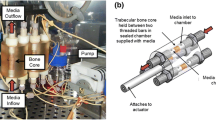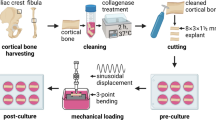Abstract
The effect of mechanical stimulation on osteogenesis remains controversial, especially with respect to the loading frequency that maximizes osteogenesis. Mechanical stimulation at an optimized frequency may be beneficial for the bone tissue regeneration to promote osteoblastic calcification. The objective of this study was to investigate the frequency-dependent effect of mechanical loading on osteoblastic calcification in the tissue-engineered bones in vitro. Tissue-engineered bones were constructed by seeding rat osteoblasts into a type I collagen sponge scaffold at a cell density of 1600 or 24,000 cells/mm3. Sinusoidal compressive deformation at the peak of 0.2% was applied to the tissue-engineered bones at 0.2, 2, 10, 20, 40, and 60 Hz for 3 min/day for 14 consecutive days. Optically-monitored calcium content started to increase on days 5–7 and reached the highest value at 2 Hz on day 14; however, no increase was observed at 0.2 Hz and in the control. Ash content measured after the mechanical stimulation also showed the highest at 2 Hz despite the differences in cell seeding density. It was concluded that mechanical stimulation at 2 Hz showed the highest promotional effect for osteogenesis in vitro among the frequencies selected in this study.





Similar content being viewed by others
References
Barbas, A., A. S. Bonnet, P. Lipinski, R. Pesci, and G. Dubois. Development and mechanical characterization of porous titanium bone substitutes. J. Mech. Behav. Biomed. Mater. 9:34–44, 2012.
Cordell, J. M., M. L. Vogl, and A. J. Wagoner Johnson. The influence of micropore size on the mechanical properties of bulk hydroxyapatite and hydroxyapatite scaffolds. J. Mech. Behav. Biomed. Mater. 2:560–570, 2009.
Dado, D., and S. Levenberg. Cell-scaffold mechanical interplay within engineered tissue. Semin. Cell Dev. Biol. 20:656–664, 2009.
Dumas, V., A. Perrier, L. Malaval, N. Laroche, A. Guignandon, L. Vico, and A. Rattner. The effect of dual frequency cyclic compression on matrix deposition by osteoblast-like cells grown in 3D scaffolds and on modulation of VEGF variant expression. Biomaterials 30:3279–3288, 2009.
Duncan, R. L., and C. H. Turner. Mechanotransduction and the functional response of bone to mechanical strain. Calcif. Tissue Int. 57:344–358, 1995.
Ehrlich, P. J., and L. E. Lanyon. Mechanical strain and bone cell function: a review. Osteoporos. Int. 13:688–700, 2002.
Frost, H. M. Perspectives: the role of changes in mechanical usage set points in the pathogenesis of osteoporosis. J. Bone Miner. Res. 7:253–261, 1992.
Hench, L. L. Bioceramics. J. Am. Ceram. Soc. 81:1705–1727, 1998.
Holy, C. E., M. S. Shoichet, and J. E. Davies. Engineering three-dimensional bone tissue in vitro using biodegradable scaffolds: investigating initial cell-seeding density and culture period. J. Biomed. Mater. Res. 51:376–382, 2000.
Hsieh, Y. F., and C. H. Turner. Effects of loading frequency on mechanically induced bone formation. J. Bone Miner. Res. 16:918–924, 2001.
Isaksson, H., T. Harjula, A. Koistinen, J. Iivarinen, K. Seppanen, J. P. Arokoski, P. A. Brama, J. S. Jurvelin, and H. J. Helminen. Collagen and mineral deposition in rabbit cortical bone during maturation and growth: effects on tissue properties. J. Orthop. Res. 28:1626–1633, 2010.
Jagodzinski, M., and C. Krettek. Effect of mechanical stability on fracture healing—an update. Injury 38(Suppl 1):S3–S10, 2007.
Kaspar, D., W. Seidl, C. Neidlinger-Wilke, A. Beck, L. Claes, and A. Ignatius. Proliferation of human-derived osteoblast-like cells depends on the cycle number and frequency of uniaxial strain. J. Biomech. 35:873–880, 2002.
Maniatopoulos, C., J. Sodek, and A. H. Melcher. Bone formation in vitro by stromal cells obtained from bone marrow of young adult rats. Cell Tissue Res. 254:317–330, 1988.
Mizuno, M., R. Fujisawa, and Y. Kuboki. Type I collagen-induced osteoblastic differentiation of bone-marrow cells mediated by collagen-alpha2beta1 integrin interaction. J. Cell Physiol. 184:207–213, 2000.
Oxlund, B. S., G. Ortoft, T. T. Andreassen, and H. Oxlund. Low-intensity, high-frequency vibration appears to prevent the decrease in strength of the femur and tibia associated with ovariectomy of adult rats. Bone 32:69–77, 2003.
Parfitt, A. M. The cellular basis of bone turnover and bone loss: a rebuttal of the osteocytic resorption–bone flow theory. Clin. Orthop. Relat. Res. 127:236–247, 1977.
Pre, D., G. Ceccarelli, L. Benedetti, G. Magenes, and M. G. De Angelis. Effects of low-amplitude, high-frequency vibrations on proliferation and differentiation of SAOS-2 human osteogenic cell line. Tissue Eng. Part C Methods 15:669–679, 2009.
Rosenberg, N., M. Levy, and M. Francis. Experimental model for stimulation of cultured human osteoblast-like cells by high frequency vibration. Cytotechnology 39:125–130, 2002.
Rubin, C. T., and K. J. McLeod. Promotion of bony ingrowth by frequency-specific, low-amplitude mechanical strain. Clin. Orthop. Relat. Res. 298:165–174, 1994.
Rubin, C. T., K. J. McLeod, and S. D. Bain. Functional strains and cortical bone adaptation: epigenetic assurance of skeletal integrity. J. Biomech. 23:43–54, 1990.
Sittichockechaiwut, A., A. M. Scutt, A. J. Ryan, L. F. Bonewald, and G. C. Reilly. Use of rapidly mineralising osteoblasts and short periods of mechanical loading to accelerate matrix maturation in 3D scaffolds. Bone 44:822–829, 2009.
Tachibana, K., and S. M. Tanaka. In vitro calcification of tissue engineered bone promoted by mechanical stimulation—effect of cell seeding density and scaffold material. Jpn. J. Clin. Biomech. 32:33–38, 2011.
Tanaka, S. M. Mechanical loading promotes calcification of tissue-engineered bone in vitro. J. Biomech. Sci. Eng. 5:635–645, 2010.
Tanaka, S. M. Intracellular Ca2+ responses of 3D-cultured osteoblasts to dynamic loading. J. Biomech. Sci. Eng. 7:318–327, 2012.
Tanaka, S. M., H. B. Sun, R. K. Roeder, D. B. Burr, C. H. Turner, and H. Yokota. Osteoblast responses one hour after load-induced fluid flow in a three-dimensional porous matrix. Calcif. Tissue Int. 76:261–271, 2005.
Turner, C. H., T. Yoshikawa, M. R. Forwood, T. C. Sun, and D. B. Burr. High frequency components of bone strain in dogs measured during various activities. J. Biomech. 28:39–44, 1995.
Volkmer, E., I. Drosse, S. Otto, A. Stangelmayer, M. Stengele, B. C. Kallukalam, W. Mutschler, and M. Schieker. Hypoxia in static and dynamic 3D culture systems for tissue engineering of bone. Tissue Eng. Part A 14:1331–1340, 2008.
Warburton, D. E. R., C. W. Nicol, and S. S. D. Bredin. Health benefits of physical activity: the evidence. CMAJ 174:801–809, 2006.
Weiner, S., and H. D. Wagner. The material bone: structure-mechanical function relations. Annu. Rev. Mater. Sci. 28:271–298, 1998.
Williams, P. A., and S. Saha. The electrical and dielectric properties of human bone tissue and their relationship with density and bone mineral content. Ann. Biomed. Eng. 24:222–233, 1996.
Wilson, C. E., W. J. Dhert, C. A. Van Blitterswijk, A. J. Verbout, and J. D. De Bruijn. Evaluating 3D bone tissue engineered constructs with different seeding densities using the alamarBlue assay and the effect on in vivo bone formation. J. Mater. Sci. Mater. Med. 13:1265–1269, 2002.
Acknowledgments
This research was partly supported by the Ministry of Education, Science, Sports and Culture, Grant-in-Aid for Scientific Research (C), 20560070.
Author information
Authors and Affiliations
Corresponding author
Additional information
Associate Editor Cheng Dong oversaw the review of this article.
Rights and permissions
About this article
Cite this article
Tanaka, S.M., Tachibana, K. Frequency-Dependence of Mechanically Stimulated Osteoblastic Calcification in Tissue-Engineered Bone In Vitro . Ann Biomed Eng 43, 2083–2089 (2015). https://doi.org/10.1007/s10439-014-1241-z
Received:
Accepted:
Published:
Issue Date:
DOI: https://doi.org/10.1007/s10439-014-1241-z




